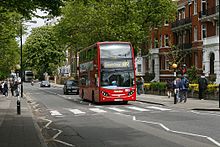
The United Kingdom has specific types of pedestrian crossing.

The United Kingdom has specific types of pedestrian crossing.
The first pedestrian crossing signal was erected in Bridge Street, Westminster, London, in December 1868. It was the idea of John Peake Knight, a railway engineer, who thought that it would provide a means to safely allow pedestrians to cross this busy thoroughfare. The signal consisted of a semaphore arm (manufactured by Saxby and Farmer, who were railway signaling makers), which was raised and lowered manually by a police constable who would rotate a handle on the side of the pole. The semaphore arms were augmented by gas illuminated lights at the top (green and red) to increase visibility of the signal at night. However, in January 1869, the gas used to illuminate the lights at the top leaked and caused an explosion, injuring the police operator. No further work was done on signalled pedestrian crossings until fifty years later. [1]
In the early 20th century, car traffic increased dramatically. A reader of The Times wrote to the editor in 1911:
"Could you do something to help the pedestrian to recover the old margin of safety on our common streets and roads? It is heartrending to read of the fearful deaths taking place. If a pedestrian now has even one hesitation or failure the chance of escape from a dreadful death is now much less than when all vehicles were much slower. There is, too, in the motor traffic an evident desire not to slow down before the last moment. It is surely a scandal that on the common ways there should be undue apprehension in the minds of the weakest users of them. While the streets and roads are for all, of necessity the pedestrians, and the feeblest of these, should receive the supreme consideration."[ citation needed ]

Pedestrian refuges are uncontrolled crossings with two dropped kerbs and a central traffic island, protected by kerbs. The island allows pedestrians to cross the road one direction of traffic at a time, which can be quicker and safer (they decrease pedestrian accidents by around 40%) than a lack of crossing. Additionally, they can narrow the road (refuges slow vehicle speeds by 6%) and prevent vehicles overtaking (as vehicles must normally pass the island on the left on a two-way road). However, they do not afford pedestrians priority unless they are located at a junction, meaning pedestrians may have a longer wait than a controlled crossing. They can also create pinch points, which can be dangerous for cyclists. [2]
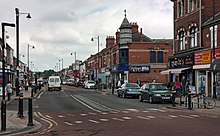
Courtesy crossings are uncontrolled crossings with coloured surfacing or some other non-formal suggestion that pedestrians may cross. They aim to encourage concentrated pedestrian crossings and to encourage drivers to let pedestrians cross the roads out of courtesy, rather than obligation (unless at a junction). The inclusion of stripes (e.g. in paving), the presence of narrowing and visual narrowings of the road positively affect courtesy. [3]
Since 29 January 2022 pedestrians crossing the mouth of a side road have priority over vehicles turning in from the main road. [4]

Zebra crossings are a type of controlled crossing indicated by white longitudinal bars across the carriageway and upright flashing globes, known as 'belisha' beacons. Zebra crossings can be used on roads where the 85th percentile speed is not above 35mph. The minimum width for a crossing is 2.4 m. [4] : 125
At a zebra crossing, pedestrians should wait for traffic from both directions to stop before moving onto the crossing. [5] : rule 19 Drivers are legally required give way when someone is crossing the road at a zebra crossing. [5] : rule 195
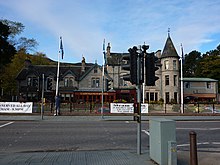

Pelican crossings, puffin crossings and pedex crossings are all types of controlled crossing controlled by traffic signals for pedestrians and drivers. These types of crossings can be used where vehicle speeds are high, where there are a lot of vulnerable pedestrians, where vehicle flows or pedestrian flows are high or where the road layout could cause uncertainty. [4] : 132
At these crossings, there will be at least two signal heads facing each direction of vehicular traffic, as well as signal heads and call buttons for pedestrians. The crossings can be staggered to shorten crossing times, mainly for the benefit of vehicular traffic flow. [4] : 132–3
While pelican crossings are no longer permitted to be installed in Great Britain (they are in Northern Ireland), pedex crossings allow the continued use of farside pedestrian signals. [4] : 142
Defunct crossings include:
There are two common types of pedestrian signal in the UK: nearside and farside. Nearside signals are incorporated into the push button, while farside signals are located at the other end of the crossing, facing the pedestrian across the road. Both types are permitted, and highway authorities can install either as they wish, though not both at the same installation. [4] : 62–3
Nearside signal units will normally be one unit, however a repeater unit may be provided higher up where there are lots of pedestrians, as nearside signals can be more easily blocked. [4] : 62–3
Farside signal heads will normally contain two signals: a red man and a green man signal. Furthermore, on the nearside there will be a push button unit, which normally contains the text "PEDESTRIANS push button and wait for signal opposite" as well as a pictorial guide to the crossing symbols. [4] : 62–3
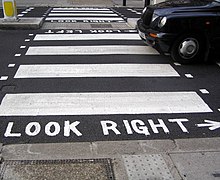
Road markings with the text "Look right" and "Look left" are sometimes used at pedestrian crossings to indicate to pedestrians the direction from which traffic will approach. Common uses may be a pedestrian island on a one way street or where a contraflow bus lane is in use. [6] At times these markings have been painted incorrectly, which can create confusing situations for pedestrians. For example, on a street in Islington, the words "look right" were painted, although the accompanying arrow pointed left and traffic approached from the left. [7]
Average installation costs are as follows. Note that the costs are based on no existing crossing, it will cost less in other cases (e.g. upgrading a puffin to a toucan).
| Type | Average cost range | Notes |
|---|---|---|
| Informal crossing (pedestrian refuge) | £5,000-£10,000 | [2] |
| Zebra/parallel crossing | £15,000-£27,000 | Requires a Traffic Regulation Order. [8] |
| Puffin/toucan crossing | £30,000-£50,000 | Requires a Traffic Regulation Order. [9] |

There are situations where other users may need to cross the road alongside pedestrians, in which case it may be practicable to use a multi-user crossing.
Parallel crossings are formed by placing a cycle track next to the bars in the zebra crossing, and allow cyclists to ride across the crossing, which they are not normally permitted to do. [4] : 129 Toucan crossings are a type of controlled, signalised crossing which can be used simultaneously by pedestrians and cyclists, as cyclists cannot use the signal-controlled pedestrian crossings. Toucan crossings generally should not be staggered. [4] : 141 Finally, a parallel crossing can be signalised by placing cycle track(s) in parallel to a puffin or pedex crossing. This is known as a sparrow crossing. [10]
Equestrian crossings can be used by horse riders. They can be sited in parallel to toucan and pedestrian facilities. [4] : 143–4
All new and updated crossings in the UK, including informal crossings must not disable people. They do this is a number of different ways.
Dropped kerb: A ramp should be provided to assist pedestrians to cross the road, as some people, especially wheelchair users, find it difficult to negotiate kerbs. Therefore, a 'dropped kerb', where the kerb is flush with the carriageway, or a raised crossing is normally provided. [11]
Tactile blister paving: Blister paving is always used at controlled and uncontrolled crossings. This is coloured red at controlled crossings (zebras, puffins, signalised junctions) and any other colour which contrasts from the footway surface at uncontrolled crossings. [11]
The guidance recommends that pedestrian push buttons be located on the right side of the crossing waiting area. This is because visually impaired people are taught to look for a push button to their right. [4] : 63

Traffic comprises pedestrians, vehicles, ridden or herded animals, trains, and other conveyances that use public ways (roads) for travel and transportation.
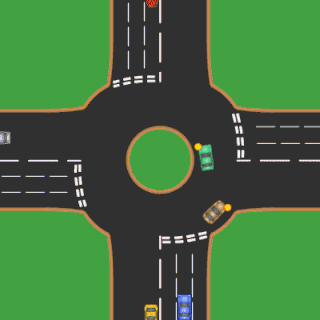
A roundabout, also known as a rotary or traffic circle, is a type of circular intersection or junction in which road traffic is permitted to flow in one direction around a central island, and priority is typically given to traffic already in the junction.

An intersection or an at-grade junction is a junction where two or more roads converge, diverge, meet or cross at the same height, as opposed to an interchange, which uses bridges or tunnels to separate different roads. Major intersections are often delineated by gores and may be classified by road segments, traffic controls and lane design.

A zebra crossing or a marked crosswalk is a pedestrian crossing marked with white stripes. Normally, pedestrians are afforded precedence over vehicular traffic, although the significance of the markings may vary by jurisdiction. They are known as "zebra" crossings as the stripes resemble the coat of a zebra.

A pedestrian crossing is a place designated for pedestrians to cross a road, street or avenue. The term "pedestrian crossing" is also used in the Vienna and Geneva Conventions, both of which pertain to road signs and road traffic.

A pelican crossing, or archaically pelicon crossing, is a type of pedestrian crossing with traffic signals for both pedestrians and vehicular traffic, activated by call buttons for pedestrians, with the walk signal being directly across the road from the pedestrian. The design is also found in the Isle of Man, the Channel Islands, the island of Ireland, Indonesia and Australia. The crossings began to be phased out in Great Britain in 2016, being replaced with puffin crossings which have pedestrian signals above the call button rather than across the road.
A Belisha beacon is an amber-coloured globe lamp atop a tall black and white striped pole, marking pedestrian crossings of roads in the United Kingdom, Ireland, and other countries historically influenced by Britain, such as Hong Kong, Malta, and Singapore. The beacons were named after Leslie Hore-Belisha (1893–1957), the Minister of Transport who, in 1934, added beacons to pedestrian crossings, marked by large metal studs in the road surface. These crossings were later painted in black and white stripes, and thus are known as zebra crossings. Legally, pedestrians have priority on such crossings.

A toucan crossing is the British term for a type of pedestrian crossing that also allows bicycles to be ridden across. Since “two can” cross together the name “toucan” was chosen. In the United Kingdom toucan crossings are normally four metres (13 feet) wide, instead of the 2.8 metre (9 feet) width of any pelican crossing or puffin crossing.

Traffic lights, traffic signals, or stoplights – also known as robots in South Africa – are signalling devices positioned at road intersections, pedestrian crossings, and other locations in order to control the flow of traffic.

A puffin crossing is a type of pedestrian crossing in use in the United Kingdom.

A pegasus crossing is a type of signalised pedestrian crossing, with special consideration for horse riders. This type of crossing is named after the mythical winged horse, Pegasus. They are primarily used in the United Kingdom and Peru.
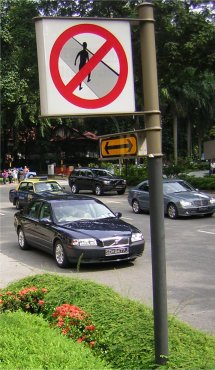
Jaywalking is the act of pedestrians walking in or crossing a roadway that has traffic if that act contravenes traffic regulations. The term originated in the United States as a derivation of the phrase jay-drivers, people who drove horse-drawn carriages and automobiles on the wrong side of the road, before taking its current meaning. Jaywalking was coined as the automobile arrived in the street in the context of the conflict between pedestrian and automobiles, more specifically the nascent automobile industry.

A hook turn or two-stage turn, also known as a Copenhagen Left, is a road cycling manoeuvre or a motor vehicle traffic-control mechanism in which vehicles that would normally turn from the innermost lane of an intersection instead turn from the outermost lane, across all other lanes of traffic.

An advanced stop line (ASL), also called advanced stop box or bike box, is a type of road marking at signalised road junctions allowing certain types of vehicle a head start when the traffic signal changes from red to green. Advanced stop lines are implemented widely in Denmark, the United Kingdom, and other European countries but the idea was first conceptualized by transportation planner Michael Lynch for the city of Portland, Oregon, in response to numerous bike crashes at intersections.
The Sydney Coordinated Adaptive Traffic System, abbreviated SCATS, is an intelligent transportation system that manages the dynamic timing of signal phases at traffic signals, meaning that it tries to find the best phasing for a traffic situation. SCATS is based on the automatic plan selection from a library in response to the data derived from loop detectors or other road traffic sensors.

Tactile paving is a system of textured ground surface indicators found at roadsides, by and on stairs, and on railway station platforms, to assist pedestrians who are vision impaired.
Driving in the United Kingdom is governed by various legal powers and in some cases is subject to the passing of a driving test. The government produces a Highway Code that details the requirements for all road users, including drivers. Unlike most other countries in the world, UK traffic drives on the left.
Road signs in Canada may conform to the Manual of Uniform Traffic Control Devices for Canada (MUTCDC) by the Transportation Association of Canada (TAC) for use by Canadian jurisdictions. Although it serves a similar role to the MUTCD from the US Federal Highway Administration, it has been independently developed and has a number of key differences with its American counterpart, most notably the inclusion of bilingual (English/French) signage for jurisdictions such as New Brunswick with significant anglophone and francophone population, and a heavier reliance on symbols rather than text legends.

A protected intersection or protected junction, also known as a Dutch-style junction, is a type of at-grade road junction in which cyclists and pedestrians are separated from cars. The primary aim of junction protection is to make pedestrians and cyclists safer and feel safer at road junctions.

The Slough experiment was a two-year road safety trial carried out in Slough, Berkshire, England, from 2 April 1955 to 31 March 1957. Different road safety innovations were tested to determine if they would reduce the number of road accidents. Amongst other innovations the experiment trialled the first linked traffic signals in the country, single yellow no-waiting lines, a keep left system for pedestrians and yield signs at junctions. The experiment also saw the first use of 20 mph and 40 mph speed limits in the UK. The experiment cost at least £133,100 and resulted in a 10% reduction in serious injuries and fatalities.
{{cite book}}: CS1 maint: others (link){{cite book}}: CS1 maint: others (link)